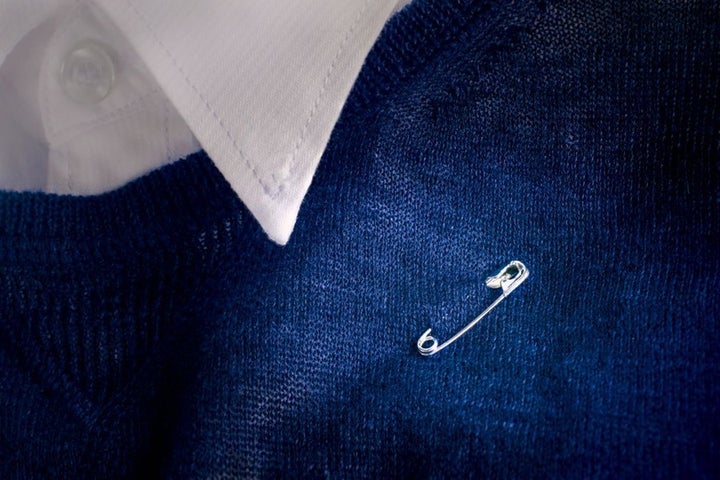
A week has passed since the election, and there’s been lively debate among progressives about whether or not to wear safety pins. Initiated by an American living in the UK, the safety pin spread there as a protest against the BREXIT vote and the xenophobia it represented. On this side of the pond, liberals have advocated for its wearing as a similar protest of the Trump win and its accompanying racism, sexism and xenophobia.
However, some people of color, LGBT advocates and White allies discourage safety pin wearing. This discouragement ranges from mocking the pin as a superficial way to alleviate white guilt to frustration about pin wearing not being accompanied by meaningful action to warnings about not wearing the pin unless the wearer is skilled in de-escalation techniques and physical self-defense. In turn, some White people have reinforced white privilege by belittling and dismissing feedback from people of color about the impact of pin wearing.
As a lifelong White ally who’s made her living doing anti-racism and diversity work, I’ve been unsure of my stand on the issue. Now that the dust has settled, here it is:
Wear the damn safety pins already. Here’s why:
- We need a broad, visible presence for majority dissent and allyship to call out the real danger Trump poses to all communities. There’s nothing like isolation to break a person’s spirit and weaken their resolve. Being able to quickly and easily identify kindred spirits everywhere builds community and keeps people strong. Also, White males wearing pins disrupt the illusion of White male unity around white supremacy and misogyny.
- White people need to start taking more risks. Wearing a removable safety pin is nothing like walking around black, brown, trans* or undocumented every day. But it’s a start. White people need to begin outing ourselves, even in small ways, and taking risks – at our workplace, gym, place of worship, grocery store and Thanksgiving table.
- White people must be accountable. Once I wear a pin or change my facebook profile picture to a safety pin, I’ve invited you to hold me accountable for my actions and give me feedback for how I’m behaving in integrity with my professed allyship or anti-racist stand.
- White people must face our own consequences. Wearing a safety pin may open people up to some life changing experiences. It may not be comfortable, but it is necessary.
- There’s no clear consensus about what the safety pin means, nor consistent expectations of pin wearers. So far, most people of color say they don’t expect anything specific from pin wearers. Also, I’ve yet to hear any reports of someone being harmed because a safety pin wearer was unable to de-escalate a situation or intervene physically. (However, there are cases, like #iwalkwithnatasha, where people are showing up as fierce allies without pins.)
So, wear the damn safety pins already. But don’t stop there. If you choose to wear a pin, consider this:
- Be clear why you are wearing the pin, and for whom. Your pin will spark conversation. What will you say when someone asks you about it, makes a snide remark, or gets in your face? Are you wearing it for people of color to see? For White people to see? To make yourself feel better or better-than? How do your reasons express your values and beliefs? What is the impact your pin might have on others? What action are you committing to, beyond wearing the pin?
- Be clear about when you wear the pin, and why. Will you wear it everywhere except work? Only at work? Will you wear it when you’re out with your kids? Will you stop wearing it in a week or two, or not until a specific event or date?
- Have a plan for what you will do while wearing the pin. What will you do if your boss or HR asks you to remove the safety pin? What will you do if you see a woman, Muslim, LGBT or person of color being harassed or attacked while wearing the pin? How will your choices affect others – your family, coworkers, those with you and people around you?
- Make a public commitment to do something in addition to wearing the pin. Attend a local SURJ meeting. Attend a local #BlackLivesMatter meeting. Have a crucial conversation with a Trump supporter or bigot you know. Take a relevant course or training. Read White Like Me, The New Jim Crow, Waking Up White, Why Are All the Black Kids Sitting Together in the Cafeteria, Between the World and Me, or A People’s History of the United States. Volunteer your time or donate money to a relevant organization or cause. Participate in a local city council, school board, or police commission meeting. Encourage your workplace to implement unconscious bias training to improve your interview and promotion process. Insist your local school district review student performance data by race, identify root causes and create an action plan. Tell 2-3 friends what you’re going to do and by when – or post it on social media – and ask to be held accountable.
People of color, LGBT and Muslims are rightly angry at us for not “waking up” to their daily, lifelong reality until Trump’s victory. They are justified in mocking and mistrusting us for wearing pins, because we’ve let them down over and over and over. This is where we start to shed our white fragility by doing it anyway, and being accountable. This is messy. It’s imperfect and incomplete. But it’s a start, and now is a time for “both-and” thinking – taking on both the symbol and meaningful action.
White ally Chris Crass recently posted, “what would be terrible is if no white people were outraged or shocked, so white people doing something not quite awesome in their effort to protest Trump and be in solidarity with people of color, those are problems we want. It’s important to [build up and see] the wide range of people who are on our side and need our support, rather than having a high bar for where people need to already be, and then tearing them down for failing.”
So let go of perfect and wear the safety pins. But whether you do or don’t, take ownership of your decision, take ownership of the problem, and take meaningful, lasting actions.
